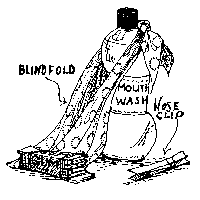Okay, Don't Quit

Chapter 5
Isolating
the Addiction
The drug nicotine forms another part of your smoking habit.
Medical estimates hold the nicotine addiction can be flushed out in about two weeks by drinking a good deal of water. That would be a simple undertaking if it weren't for the nicotine connection to the other parts of your habit.
With that in mind, the next phase of the program focuses on isolating your addiction cigarettes from your other habit connections. You will learn to disconnect your addiction cigarettes from your nervous habit cigarettes and break their tie with other reinforcers.
Once the nicotine cigarettes are isolated, they can be handled by reducing their numbers. To this end, it should be noted that reducing your habit cigarette smoking also helps pull your daily totals down and decreases your addiction level.
The Ground Rules
The ground rules are easy: If you need an addiction cigarette, you can have it. That's the beauty of this system. You never have to struggle through the nagging need to have a cigarette and forcing yourself to avoid it. When the urge surfaces and begins exerting its relentless pull, you don't have to fight it — you can have the cigarette.
The ability to smoke when you need to should take the pressure off. In fact, it makes the program easy compared to every other "cold turkey" and willpower-oriented approaches. The catch, however, is that your addiction cigarettes must be isolated from other activities.
Addiction Zone
The easiest way to isolate addiction cigarettes involves finding an addiction smoking zone. Your isolation zone should lack your normal comforts and sensory input. It's a spot only for smoking addiction cigarettes.

Isolation does not mean having a cigarette on the back porch with a nice view, sounds of the birds chirping, and a fragrant spring breeze. Being alone in a stimulating environment is not isolation. Isolation is boring, bland, and quiet.
The addiction smoking zone should isolate you from all positive sensory input. No hot radio tunes, no pretty people walking by. If the zone smells good, you'll need nose plugs. No day dreaming about your upcoming camping trip. Nothing but you and your addiction cigarette.
Isolation means finding a spot in the garage with a blank wall. Stand about two feet from the wall and face the blank spot. Now smoke your addiction cigarette. Nothing else can be happening.
The addiction cigarettes are not going to be that much fun, but remember, you don't have to give them up cold turkey.
Before moving on, you may wish to practice the confusion and isolation techniques and let them sink in thoroughly. Allow at least three days to a week. If your smoking doesn't quite feel the same after that period, you're on the right track. Be creative and bold with your isolation attempts. Surprise yourself.
The more variations you can create for isolating and confusing your habit, the better. Each new wrinkle prevents you from getting comfortable and letting that old sameness creep back into your habit. If you run out of ideas, consider how your favorite movie/TV personality might approach it. Imitate and exaggerate how people around you smoke. Get silly, serious, or gross — whatever helps you create new ways to confuse your habit.
When you feel ready for more change, continue with the next exercise.
More Isolation
Once you've worked on using an isolation zone for a while, say a week, it's time for more isolation. More isolation than smoking in a corner of the garage facing a dirty wall? Yes.
At this stage in your program, it's essential you prevent your senses from intruding into your isolation efforts.
First, check what your five senses are doing while you're having a cigarette in the addiction zone. Most likely you still taste the cigarette, still watch the smoke, still feel the cigarette in your hand, still smell the smoke, and still hear yourself exhale. If so, your senses are still actively involved. This is not full isolation.
To complete the isolation, you need to prevent each of your senses from getting involved as you smoke the cigarette. For example, you can cover the cigarette's taste with some gum or mouth wash. Close your eyes when you blow out the smoke. Get your hands out of the act — hold the cigarette with a pair of pliers. Hold your nose. Wear a pair of earplugs.
A few weeks of these antics and the old addiction cigarettes will never be the same. That's the point!
Even though these suggestions sound funny, they are deadly serious. They will save your life.
Everyday Life
These isolation adjustments are an important part of the program, and as such, they need to extend beyond the limits of your house and into the real world. This means taking your earplugs, nose plugs, and mouthwash to work. No excuses for parties, weddings, or camping trips. Your need to find the equivalent of your blank wall at home and smoke your addiction cigarette there.
Remember, you are committed to giving the program a chance.
If you slip-up and have a couple of cigarettes in your old "use all the senses" manner, it's not a problem. Just get right back on track.
A sample on-the-road isolation package:

The Payoff
In a relatively short period, these isolation and disruption maneuvers will begin to break down your old habit connections. Each day your habit will become a little weaker. Every time you smoke in a different way or isolate your cigarette, you strip away more of your habit's strength. Stay with it and your smoking habit will soon be in disarray.
 As the exercises take their toll, your smoking
habit will become more and more disoriented.
As the exercises take their toll, your smoking
habit will become more and more disoriented.